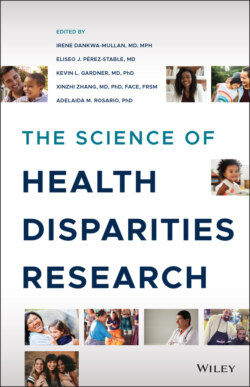Читать книгу The Science of Health Disparities Research - Группа авторов - Страница 43
2.9 Key Points
ОглавлениеThe domains that have the greatest impact on health disparities include environmental, social, behavioral, and biological determinants. These domains are inextricably linked and their combinations may have synergistic impacts on health disparities.
The concept of allostatic load provides a conceptual framework from which to understand the root or fundamental causes of health disparities in sleep, diet/nutrition, and depression.
The concept of allostatic load provides the mechanistic underpinnings revealing the biological factors that link the influence of societal conditions (e.g., socioeconomic status, social isolation, racism) to disparities in health and disease outcomes.
Understanding the biological pathways through which environmental and behavioral determinants affect health disparities will provide scientific insights that could inform interventions to decrease health disparities.
Sleep is an essential human need for maintaining biological homeostasis.
Poor sleep is a gateway to higher allostatic load and numerous mental and physical health conditions such as anxiety and depression, obesity, hypertension, type 2 diabetes, cardiovascular disease, and premature mortality.
Large racial/ethnic disparities in sleep and sleep disorders exist. Therefore, preventing or minimizing the impact of modifiable environmental and social disturbances on sleep duration, quality, and timing could help mitigate racial/ethnic and socioeconomic disparities in common chronic health conditions associated with rising levels of allostatic load.
Addressing sleep disparities to prevent subsequent poor health outcomes will require more racial/ethnic minority inclusion in scientific studies.
Disparities in the consumption of nutritious food are associated with disparities in health and well‐being.
Food deserts and food insecurity are more likely to be concentrated in neighborhoods with a high proportion of minority and low‐income populations, which likely contributes to health disparities.
While racial and ethnic disparities in many physical illnesses have been clearly established, the depression disparities have not been clearly delineated.
Individuals of low SES and racial/ethnic minorities (especially Blacks, Hispanics/Latinos, and Native Americans) usually live and work in environments with limited material and social resources and increased probability of exposure to threats—and, thus, report higher levels of stressors and stress than high‐SES and White individuals. Nonetheless, Blacks and Hispanics/Latinos have been less frequently given depression diagnoses than Whites.
Research should focus on identifying key developmental periods in the life course to target the antecedents of allostatic load which, in addition to delineating key areas of vulnerability and resilience, may yield effective interventions to decrease depression rates among vulnerable populations.
